The Cheungs were originally attracted to Windsor Terrace because of what Mr. Cheung described as “a mix of old-school Brooklyn and new families.”
Advertisement
Continue reading the main story
In 1999, he and Mrs. Cheung, the assistant administrator at the law firm Ostrolenk Faber, purchased a two-bedroom duplex condo facing Prospect Park for under $300,000. Mr. Cheung said that neighbors have recently sold similar properties for around $900,000.
Back in January 2015, Mr. and Mrs. Cheung were out on a neighborhood stroll when they saw a for-rent sign in the window of a storefront that had gone through many incarnations in recent years, including ice cream shop, oyster bar and tiny upscale cafe.
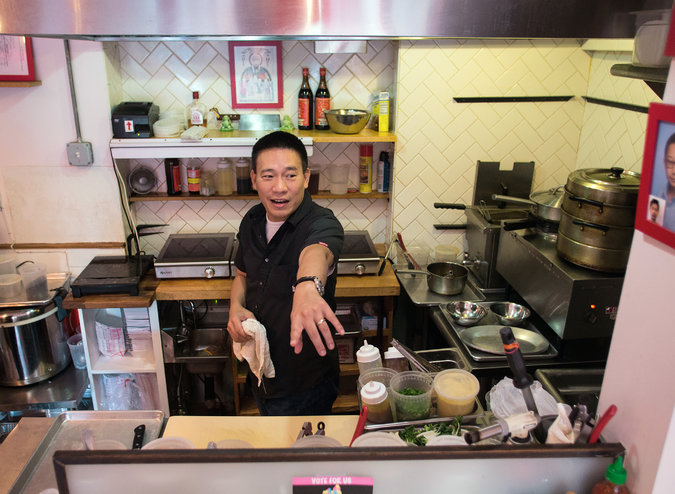
“When I saw the space, it reminded me of the restaurants I used to go to as a kid in Chinatown,” Mr. Cheung said. “They’re like Chinese teahouses with the focus on snacks — dumplings and bao. I thought, here’s this spot near my house — we’d be opening up a neighborhood restaurant.” Within two weeks, Mr. Cheung, whose lengthy culinary résumé includes stints at Jean-Georges, Nobu, the Monkey Bar and Almond Flower Bistro, had signed a five-year lease on the place.
An obvious benefit of staying local is that although he puts in 10- to 12-hour days, five to six days a week, his commute is practically nonexistent. And it’s unlikely that his policy of shuttering the restaurant on Sundays to spend time with his wife and son would fly in a neighborhood that wasn’t already so focused on family.
Mr. Cheung said he had matured since his days at the helm of big-time restaurant kitchens. In Windsor Terrace, he said, sounding contented, “I’m known as the ‘dumpling guy.’ I’m known for making good food.”
For some business owners, opening up shop in a neighborhood is the impetus to further commit to the area by purchasing a home and becoming a full-time local.
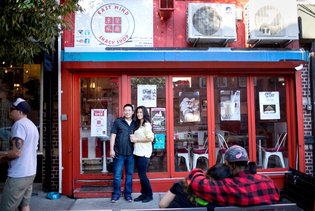
Up in the Washington Heights section of Manhattan, James Lee, 48, a contestant in 2011 on Season 7 of the Food Network’s “Chopped,” resides just steps from his eclectic neighborhood cafe, 181 Cabrini, at 854 West 181st Street, and about a dozen blocks from Buddha Beer Bar, a sports-oriented establishment at 4476 Broadway, which he also owns.
“I’m a neighborhood kind of guy,” said Mr. Lee, who was born in Busan, South Korea, and grew up in Toronto. “I used to have a restaurant in Midtown. I didn’t like it. Everybody wants things right away. We catered to law firms. They’re just miserable, so I didn’t know why I was bothering.”
Advertisement
Continue reading the main story
Mr. Lee opened 181 Cabrini in 2008, and then in 2010, along with his wife, Verena Cimarolli, 47, a senior research scientist for the Research Institute on Aging of the New Jewish Home, moved to their two-bedroom co-op from Harlem. Mr. Lee declined to reveal the purchase price, but according to Jonathan J. Miller, the president of Miller Samuel, a real estate appraisal firm, similar properties in the area have sold for a median price of $581,392 over the last six months.
In 2012, Mr. Lee opened Buddha Beer Bar, a spot where locals convene for fantasy football, trivia night and craft beer. Next month, Mr. Lee and his sister will close on an investment property, a townhouse in nearby Hamilton Heights. John Keenan, a salesman with Douglas Elliman Real Estate, helped them with their search.
Tips for Neighborhood Business Owners
Hire the Right Help “Hire someone to oversee the construction,” advised Terri Gloyd, an owner with Annie Tsantes of LIC Corner Cafe in Long Island City, Queens. “We had an offer from a guy to do the whole renovation for $70,000, and I thought, ‘That is so much money!’ It probably would have been smart to do it.” Look to the Locals “There’s this Russian guy that lives up the street and he introduced us to this Polish woodworker who put the wood in around our windows and front door,” Ms. Gloyd said. “Annie’s son Rowan put our electricity in, and her other son, Damien, put our air-conditioners in. My son helped to move equipment.” Prepare for Obstacles “This city makes it hard to do small businesses,” said Chris Cheung, the owner of East Wind Snack Shop in Windsor Terrace, Brooklyn. “I’ll be flat out — the city almost makes you feel like they don’t want you to open a business. From permits to fees to signing onto your cable and internet, it’s a thousand-piece jigsaw puzzle.” Don’t Push Product When it comes to her clothing, Lia Kes, a fashion designer and shop owner on the Upper West Side, strives to create a relationship with regular customers. “I say: ‘If you don’t need it and it won’t leave your closet enough times, leave it here. We’ll sell it to someone else.’” Bring Your ‘A’ Game“You need that Type A personality in order to do this,” said James Lee, who owns a cafe and a sports bar in Washington Heights. “You have to be able to multitask. It’s not about the food, it’s about ‘How many balls can I put in the air without dropping them?’”
“I definitely see the purchase as a way of James investing further into his community, as he’s been doing in Washington Heights and Harlem for the past 10 years,” Mr. Keenan said.
Mr. Lee feels that by keeping his ventures near home, he’s “carved out a living without all the hassles,” he said, which includes being able to pick up his son, Noah Lee, 8, at the bus stop every day after school.
“I design my schedule so that I have pockets of free time. I coach his soccer team, I’m coaching his hockey team. Even though my wife and I both work full time, he’s never had a babysitter.”
Mr. Lee calls Washington Heights one of the “last real neighborhoods in New York City,” where different cultures coexist and everyone’s “just trying to make it.”
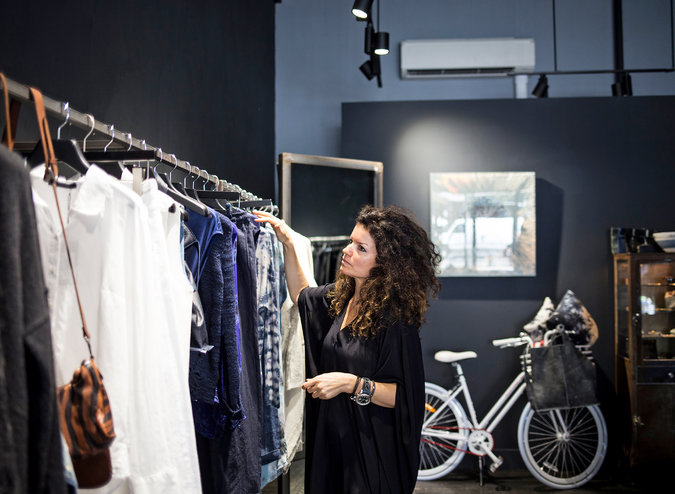
Credit Alex Wroblewski for The New York Times
“The only thing that matters in a neighborhood are the restaurants, bars and cafes,” he said. “It used to be about being near shops. Nobody cares about shops, even grocery shops — everyone gets Fresh Direct. No one cares to be close to the Gap. How many times do you need to go get a T-shirt? The social fabric is here, in the restaurants.”
And, he said, owning a restaurant near home means a better quality of life, not just for him, but also for his employees. “I like to hire guys from the neighborhood,” he said. “I think one of the most stressful parts of your job is the commute. So if you eliminate that, it’s a little bit simpler.” Hiring locals also has a practical side: “They can’t give me no lie that the train was stuck!”
For some, living in such proximity to the shop would mean blurred lines between home and work. But for Mr. Lee, those lines don’t exist. “You can’t really separate the business from your life when you’re this close,” he said. “I step out my door and I’m at work.”
Advertisement
Continue reading the main story
Sometimes, living in a neighborhood gives you perspective on what your community is lacking.
When Terri Gloyd, 62, made trips to the dog run with her spaniel in Long Island City, Queens, she would often stare at an abandoned Filipino grocery near her building, and envision the possibilities. The area had restaurants and a nice market, she said, but there seemed to be room for a cafe.
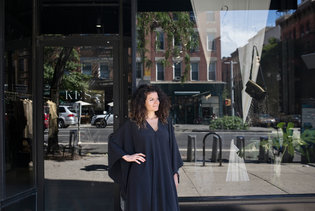
In November 2015, she and her business partner, Annie Tsantes, 65, opened LIC Corner Cafe at 21-03 45th Road. Ms. Gloyd has resided around the corner from the spot since 1987, while Ms. Tsantes has lived in the very building that houses the cafe since 1980 — she’s its superintendent.
“Neither of us have owned a business before,” said Ms. Gloyd, who arrives at the cafe at 6:30 a.m. each day to start making baked goods such as blueberry pie, while Ms. Tsantes comes in for the later shift and focuses her attention on preparing savory dishes. The partners, who were acquaintances, have fallen into what they call a “sisterly” relationship, divvying up the work without really talking about it.
“We now know the old neighborhood and the younger crowd who are buying these new condos,” Ms. Gloyd said. “This isn’t just about money for us. It’s about community.”
Ms. Tsantes’s brother owns the building that houses the cafe, and did not charge rent during the time it took to complete the gut renovation. “That’s what allowed us to do this,” Ms. Gloyd explained. The rent on the cafe started at $1,500 a month and has now increased to $1,800 a month.
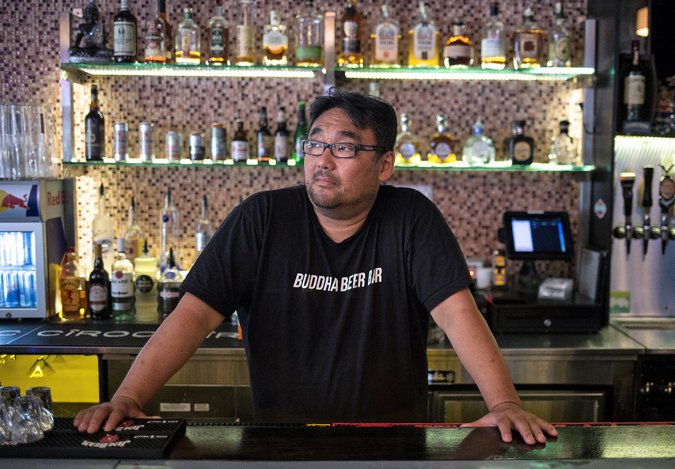
Ms. Gloyd and her husband, Pat Irwin, 61, a composer, secured a piece of the neighborhood before it was popular, purchasing their two-bedroom apartment for $60,000 in 1994.
“Long Island City was like a secret, easy-to-get-to, quiet neighborhood with lots of old factories,” Ms. Gloyd said. “It was a great place for a kid to grow up. We have a lot of friends that live in the neighborhood. It feels like a small town, and we love that about it.”
The cafe is the definition of mom-and-pop — Sam Irwin, 22, the son of Ms. Gloyd and Mr. Irwin, and a recent graduate of Bennington College, fills in at the cafe. Other employees include Natalie DeSabato, 26, a resident of nearby Ridgewood who secured herself a spot on the payroll by enticing the women with the homemade dough that they now use for their chocolate chip cookies. Julie Powell, the author of “Julie Julia,” who met Ms. Gloyd at the dog run, works there part time as a barista.
Advertisement
Continue reading the main story
The women were initially wary when a popular coffee chain opened a block away, but they have since realized it’s not direct competition.
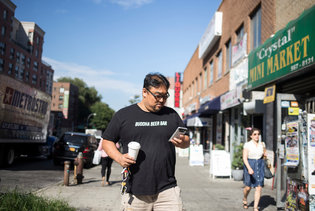
“We carry Toby’s,” Ms. Gloyd explained, referring to Toby’s Estate Coffee, the Brooklyn-based small-batch coffee roasters. “We have water filters, everything’s weighed, we’ve taken classes.”
Besides offering what they believe is a better brew, they have Ms. Gloyd’s homemade focaccia. And every month the cafe features the work of a different local artist on its walls.
Lia Kes, 44, a fashion designer, opened her boutique, KES NYC, in March 2014, not downtown, but on the Upper West Side, her home of 15 years, not counting a brief sojourn in San Francisco. The shop, at 463 Amsterdam Avenue, features her seasonless, utilitarian-yet-feminine clothing.
“There was nothing expected about it, and yet it’s needed,” said Ms. Kes of her business, striking a glamorous figure in her Elongated Kimono Dress in black silk and a wild mane of hair. “I feel that this is my role in the community,” Ms. Kes said.
Reared on a kibbutz in Israel, she says she is drawn to her neighbors. “On the Upper West Side there is something very special that I feel and recognize in the casualness of people, the ‘no big deal’ of who they are,” she said. “And I’m very appreciative of that.”
She described her shop as a living room for her neighborhood’s “super successful, beautiful women.”
“Women are coming in, and they might have coffee with us,” Ms. Kes said. “Some will pass by and say hi and it’s a conversation that may lead to buying something — or not.”
Ms. Kes, who has two daughters, Sunnye Lyri Berman, 11, and Orrie Love Berman, 9, rents a two-bedroom apartment for $7,000 a month just steps from her store. She is working with Anat Patishi, a saleswoman with DJK Residential, to find a home in the $2 million range, and has limited her search to a radius of a few blocks.
Advertisement
Continue reading the main story
“I think there is something very beautiful and human in opening a business in a place that you feel a connection to,” Ms. Kes said. “If you feel like part of the community and you see an opening and there is a void you can fill, there’s something very organic and beautiful about that.”
Continue reading the main story
Article source: http://www.nytimes.com/2016/10/09/realestate/keeping-it-local.html?partner=rss&emc=rss
Speak Your Mind
You must be logged in to post a comment.